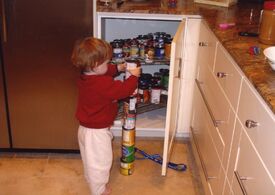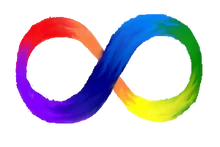
Stacking cans (or otherwise sorting objects) at a very young age may be an early indicator of Autism.
Autism Spectrum Disorder is the original name of a neurological developmental disability or condition, written by Leo Kanner in 1943. Kanner's version is now known as Kanner's Syndrome or Classic Autism. An Autism Acceptance Month flyer summarized Autism as;
A developmental disability, which affects language and communication, sensory processing and motor skills, cognition, and interaction."[1]
|
According to the Autism Society of America;
History
The word "Autism" was not an original term when it was coined by Leo Kanner in 1943. In 1911, Eugen Bleuler included "Autism" as two factors in the diagnosis of schizophrenia (the other being "ambivalence").[2] He derived the term from the Greek word autos (αὐτός, meaning self)[3] as part of an expansion of the work of Emil Kraepelin. Kanner had help in his studies from George Frankl, a man who had previously worked with Hans Asperger in Germany in the 1930's.[4]
When Kanner wrote his 1943 paper, he based it on eleven children in his care at Johns Hopkins Hospital.[5] Unfortunately his work was being mixed up with Bleuler's work and this led to a narrow interpretation of Autism. As a probable result, schizophrenia was included in the ICD-6 in 1949 but Autism was not.[6] The same error was made in the DSM-I,[7] and remained uncorrected in the ICD-7 in 1955[8] and the ICD-8 in 1965.[9]
The lack of recognition of the condition - it can be argued - led to wholesale errors across the still developing psychiatric community. This was because Autism and schizophrenia were still seen as linked until the 1960's at least.[10] Psychologist Bruno Bettelheim caused a storm in the early 1960's revealing the "Refrigerator Mother" theory as the cause of Autism.[11] He may well have published this in his book The Empty Fortress: Infantile Autism and the Birth of the Self. But before this, Bernard Rimland countered the theory in 1964 in his book Infantile Autism: The Syndrome and its Implications for a Neural Theory of Behavior.[12] Bettelheim also compared Autism to being a prisoner in a concentration camp, a theme that was adopted in another manner in the 21st century by Autism Speaks through their Ransom Notes and I am Autism campaigns.
Finally in 1975, the ICD-9 recognised "Infantile Autism" under code 299 (Psychoses with origin specific to childhood).[13] The DSM-III quickly followed suit in 1980, but then in a massive revision in 1987 expanded this to "Autism disorder".[14] At the same time of this revision, Ivar Lovaas published a study claiming success through "intensive behavioral therapy". The Lovaas Method later became known as the much maligned (and rightly so in part) Applied Behavioral Analysis.[15]
In 1992, Kanner's work ceased to be the only reference when the work of Hans Asperger was incorporated into the ICD-10 under section V:F84.[16] This expanded the definition to include a number of different conditions especially when the DSM-IV was introduced in 1994.
In 1996, Sula Wolff added another name to the historical mix - Grunya Sukhareva. She had also done work studying Autistic children, in 1925; nearly 20 years before either Kanner or Asperger. Her work had been translated to German a lot earlier but as Sukhareva was Jewish Nazi Germany likely destroyed her work. Along with the fact that she was Russian.
In the DSM-5 in 2013 the different conditions were combined into one name - Autistic spectrum disorder.[17] As such, it affects each person in a different way. Each autistic person has different specific symptoms, and each of their symptoms can be different in intensity, suggesting that the diagnosis a person received often depended on which doctor they saw,[18] and autistic people are extremely diverse to the point that any subcategories would have very little meaning.[19]
Related conditions
As indicated by history, for a long time, Kanner's work was the standard and nothing else mattered. But as more varied information became available, other conditions similar, crept in to the equation. Under the DSM-IV, Autism was expanded and four other types were introduced.
Under the DSM-5 these names were all combined with Autism to create the single core diagnosis of Autistic spectrum disorder.
Autism Rights
"We are fighting for inclusion in a broader society that is not like us."[20]
The autistic rights movement is a considerable element of autistic culture. This movement encourages autistic people to be themselves, and to view themselves not as defective, but as different and in need of accommodations instead of elimination.[21] Similar to Deaf culture, it is one facet of the larger disability rights movement and shares ground with intersectional feminism.
Autistic Culture

The rainbow infinity sign symbolizes neurodiversity and Autism, instead of the mysterious puzzle sign.
Autistic people have developed their own culture, one that operates largely through the internet, self-advocacy organizations, and blogs.[22] Autistic culture supports autistic individuals, and educates parents and loved ones on how to help.
Emotional Support
Many autistic people come to the community seeking support, after heavy damage to their self-esteem, or in the hopes of keeping the Autism discourse from doing the same damage to other autistic people. Initiatives such as Autism Acceptance Month and Autistic Pride Day aim to improve autistic people's self-esteem, and to encourage education and inclusion in the mainstream world.
Ari Ne'eman views autistic people's access to autistic culture as essential.
It should be your birthright, however you communicate and experience the world. We should be addressing the barriers, from society and from our selves, that have kept autistic people from fully participating in autistic community life. I believe opening up Autistic culture and community is important for another reason: we have something very important to offer.[23]
Parents and allies are encouraged to access autistic culture as listeners, to hear autistic perspectives, receive helpful tips, and learn more about what it is life is like for autistic people.
See also
External links
- Autism Information Page
- Autistic Self Advocacy Network: About Autism
- Autism Women's Network
- Autism Society of America (ASA)
- ASA - Facts & Statistics
- Youtube: Ask an Autistic
- www.asdvoices.blogspot.com
- Autism Acceptance
References
- ↑ Autism Acceptance Month: What Is Autism? (pdf)
- ↑ http://www.britannica.com/biography/Eugen-Bleuler Eugen Bleuler: Swiss psychiatrist
- ↑ http://www.autismuk.com/home-page/history-of-autism/ Autism UK: History of Autism
- ↑ http://aut.sagepub.com/content/early/2016/09/12/1362361316654283.short?rss=1&ssource=mfr
- ↑ http://www.autismuk.com/home-page/history-of-autism/ Autism UK: History of Autism
- ↑ http://www.wolfbane.com/icd/icd6h.htm International Classification of Diseases, Revision 6 (1948)
- ↑ http://www.turkpsikiyatri.org/arsiv/dsm-1952.pdf DSM-I
- ↑ http://www.wolfbane.com/icd/icd7.htm International Classification of Diseases, Revision 7 (1955)
- ↑ http://www.wolfbane.com/icd/icd8.htm International Classification of Diseases, Revision 8 (1965)
- ↑ http://www.webmd.com/brain/autism/history-of-autism Web MD: A History of Autism
- ↑ http://www.parents.com/health/autism/history-of-autism/ Parents.com: The History of Autism
- ↑ http://autism-help.org/points-refrigerator-mothers.htm REFRIGERATOR MOTHERS - A DISCREDITED CAUSE OF AUTISM
- ↑ http://www.wolfbane.com/icd/icd9h.htm International Classification of Diseases, Revision 9 (1975)
- ↑ http://www.parents.com/health/autism/history-of-autism/ Parents.com: The History of Autism
- ↑ http://www.parents.com/health/autism/history-of-autism/ Parents.com: The History of Autism
- ↑ http://apps.who.int/classifications/icd10/browse/2010/en#/F84.5 ICD-10 Version: 2010
- ↑ https://web.archive.org/web/20101225152454/http://www.dsm5.org/ProposedRevisions/Pages/proposedrevision.aspx?rid=97 DSM-5 Development. American Psychiatric Association (archive version)
- ↑ http://www.wired.com/2010/10/exclusive-ari-neeman-qa/ Wired Exclusive: First Autistic Presidential Appointee Speaks Out
- ↑ https://sfari.org/news-and-opinion/viewpoint/2011/why-fold-asperger-syndrome-into-autism-spectrum-disorder-in-the-dsm-5 Why fold Asperger syndrome into autism spectrum disorder in the DSM-5?
- ↑ ASAN Autistic Pride Day 2015: A Message to the Autistic Community
- ↑ "I am not a puzzle, I am a person"
- ↑ Culture of Autism Presentation
- ↑ Autistic Pride Day 2015: A Message to the Autistic Community
